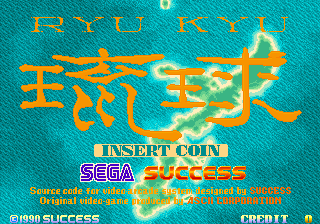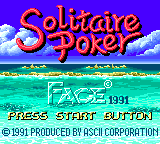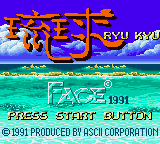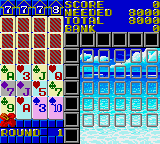Solitaire Poker
From Sega Retro
| Solitaire Poker | ||||||||||||||||||||||||||||||||||
|---|---|---|---|---|---|---|---|---|---|---|---|---|---|---|---|---|---|---|---|---|---|---|---|---|---|---|---|---|---|---|---|---|---|---|
| System(s): Sega System 16, Sega Game Gear | ||||||||||||||||||||||||||||||||||
| Publisher: Sega Enterprises, Ltd. Sega Enterprises, Ltd. (US/EU) Face (JP) | ||||||||||||||||||||||||||||||||||
| Developer: ASCII Login Soft Sega Enterprises, Ltd. Success Face | ||||||||||||||||||||||||||||||||||
| Peripherals supported: Gear-to-Gear Cable | ||||||||||||||||||||||||||||||||||
| Genre: Puzzle[1][2][3] | ||||||||||||||||||||||||||||||||||
| Number of players: 1-2 | ||||||||||||||||||||||||||||||||||
| ||||||||||||||||||||||||||||||||||
|
Solitaire Poker, known in Japan as Ryukyu (琉球), is a puzzle game developed by ASCII and Login Soft for various Japanese home computers. It was ported to Sega System 16 arcade hardware by Success and Sega Enterprises, Ltd. in 1990. Face ported it to the Sega Game Gear the following year, with Sega releasing it overseas as Solitaire Poker.
Contents
Gameplay
Game Gear version
The game is a card game with the objective of building the best poker hands by picking one card at a time. The left side of the screen contains a group of 24 cards, arranged in six rows of four cards each, with most of the cards turned down but at least one row on the bottom turned up. Cards are drawn from a standard deck of 52 cards plus a Joker (which acts as a wildcard). The right side of the screen shows a group of 25 blank spaces, arranged in five rows of five spaces each, where cards can be placed.
The player chooses a card from the lowermost row on the left side of the screen, then places it in one of the blank spaces on the right side of the screen. Cards and spaces are chosen using ![]() or
or ![]() and picked up and dropped with
and picked up and dropped with ![]() . When a card is taken from the left side, the card above it takes its place. Cards are placed in the lowermost blank space of the selected column. While the column can be chosen freely, a card can only be placed in a row if the spaces below it are filled. Sets can be made horizontally, vertically, or diagonally. As the player completes rows and columns on the right side of the screen, the type of set that was made (if any) is shown as an icon next to the row, above the column, or in the top-left or bottom-left corner (for diagonal sets).
. When a card is taken from the left side, the card above it takes its place. Cards are placed in the lowermost blank space of the selected column. While the column can be chosen freely, a card can only be placed in a row if the spaces below it are filled. Sets can be made horizontally, vertically, or diagonally. As the player completes rows and columns on the right side of the screen, the type of set that was made (if any) is shown as an icon next to the row, above the column, or in the top-left or bottom-left corner (for diagonal sets).
Success is a combination of luck (since the cards are presented to the player in random order) and the player's ability to anticipate possible combinations before they appear.
Modes
1P
A single-player mode containing 15 rounds. The player must obtain a minimum number of points in the round (depending on the mode selected) in order to progress to the next round. Each round requires progressively more points in order to clear. If the player exceeds the number of points needed to advance, the excess points are stored in the "Bank" and can be used to make up for a deficit of points in a subsequent round. There are three variations of this mode:
- In View 1, only the lowest row of cards are turned up.
- In View 2, the three lowermost rows are turned up, and the point requirement for each round has been raised. This allows the player to plan ahead when forming sets, though still only the lowest row of cards can be selected.
- In View 3, rounds rotate between three patterns: the lowest row of cards are turned up, the three lowermost rows are turned up, and all 24 cards are turned up. The point requirements are likewise raised for this variation.
There is no time limit; the game continues until the player fills the grid. The current score and the points needed to progress to the next round are shown in the top-right corner of the screen.
Try-1
A single-player mode containing a single round but with a much higher point requirement to clear. There are four variations of this mode:
- On Easy, the lowest row of cards are turned up, and 11,000 points are needed to clear.
- On Normal, the three lowermost rows are turned up (though still only the lowest row can be selected), and 13,000 points are needed to clear.
- On Hard, all 24 cards are turned up, and 15,000 points are needed to clear.
- On Casino, none of the cards are turned up (so the card can only be seen when placing it), and 9,000 points are needed to clear.
There is no time limit; the game continues until the player fills the grid. The current score and the points needed to clear the round are shown in the top-right corner of the screen.
Vs
A two-player mode for two Game Gears linked together using a Gear-to-Gear Cable. Both players compete to try to achieve the highest score in the best of five rounds. Players can separately select whether to play under a time limit (30, 60, or 90 seconds, or Free for no time limit). There are two variations of this mode:
- In Type A, the three lowermost rows of cards are turned up (though still only the lowest row can be selected). Each time a player makes a set, the player gains time back on the timer.
- In Type B, the three lowermost rows are turned up. Each time the player completes a set, the player gains time back on the timer and the number of cards that the opponent can see are reduced, depending on the set. The number of cards the opponent can see is reduced by 1 for Three of a Kind, by 2 for a Straight, by 3 for a Flush, by 4 for a Full House, by 5 for Four of a Kind, by 6 for a Straight Flush, by 7 for a Royal Straight Flush, and by 8 for Five of a Kind.
Sets
The rank of a card is the number or name on it: 2, 3, 4, 5, 6, 7, 8, 9, 10, Jack, Queen, King, or Ace.
The suit of a card is its grouping: clubs, spades, hearts, or diamonds.
The Joker card is a wildcard with no suit that can substitute for any other card in completing a set. There is only one Joker card in the deck.
In order of increasing value:
| Set | Point value | Description |
|---|---|---|
| One Pair (1P) | 200 | Two cards of one rank. |
| Two Pairs (2P) | 400 | Two cards of one rank and two cards of another rank. |
| Three of a Kind (3K) | 800 | Three cards of one rank. |
| Straight (ST) | 1,000 | Five cards of sequential rank, but not in the same suit. |
| Flush (FL) | 1,400 | Five cards in the same suit, but not of sequential rank. |
| Full House (FH) | 1,800 | Three cards of one rank and two cards of another rank. |
| Four of a Kind (4K) | 2,000 | Four cards of one rank. |
| Straight Flush (SF) | 2,400 | Five cards in the same suit of sequential rank. |
| Royal Straight Flush (RSF) | 2,800 | An Ace, King, Queen, Jack, and 10 in the same suit. |
| Five of a Kind (5K) | 3,000 | Five cards of one rank. This set is only possible to achieve with a Joker since there are only four of each rank of card in a deck. |
Pressing ![]() during a game toggles an overlay showing all of the possible sets and their point values.
during a game toggles an overlay showing all of the possible sets and their point values.
Versions
Localised names
| Language | Localised Name | English Translation |
|---|---|---|
| English | Solitaire Poker | Solitaire Poker |
| English (US) | Solitaire Poker | Solitaire Poker |
| Japanese | 琉球 | Ryuu Kyuu |
Production credits
- Main article: Solitaire Poker/Production credits.
Magazine articles
- Main article: Solitaire Poker/Magazine articles.
Physical scans
System 16 version
Game Gear version
| ExpandSega Retro Average |
|---|
| 72 | |
|---|---|
| Based on 24 reviews | |
Technical information
ROM dump status
| System | Hash | Size | Build Date | Source | Comments | |||
|---|---|---|---|---|---|---|---|---|
| ? | 128kB | Cartridge (JP) | ||||||
| ? | 128kB | Cartridge (US/EU) |
References
NEC Retro has more information related to Ryuu Kyuu
|
- ↑ File:SolitairePoker EU Box Back.jpg
- ↑ File:SolitairePoker JP cover.jpg
- ↑ Jump up to: 3.0 3.1 http://sega.jp/fb/segahard/gg/soft_licensee.html (Wayback Machine: 2013-01-01 20:24)
- ↑ Sega Arcade History, Enterbrain, page 104
- ↑ GamePro, "October 1991" (US; 1991-xx-xx), page 95
- ↑ Electronic Gaming Retail News, "September 1991" (US; 1991-0x-xx), page 28
- ↑ Computer Trade Weekly, "" (UK; 1991-12-02), page 23
- ↑ Computer Trade Weekly, "" (UK; 1991-12-09), page 27
- ↑ Computer Trade Weekly, "" (UK; 1991-12-02), page 23
- ↑ Computer Trade Weekly, "" (UK; 1991-12-09), page 27
- ↑ Jump up to: 11.0 11.1 Sega Force, "Februrary 1992" (UK; 1992-01-23), page 80
- ↑ ACE, "January 1992" (UK; 1991-12-08), page 106
- ↑ Ação Games, "Abril 1992" (BR; 1992-04-xx), page 43
- ↑ Beep! MegaDrive, "May 1991" (JP; 1991-04-08), page 29
- ↑ Console Mania, "Ottobre 1992" (IT; 1992-xx-xx), page 57
- ↑ Console XS, "June/July 1992" (UK; 1992-04-23), page 149
- ↑ Famitsu, "1991-xx-xx" (JP; 1991-06-14), page 20
- ↑ GamePro, "November 1991" (US; 1991-xx-xx), page 112
- ↑ Gamers, "Februar/März 1992" (DE; 1992-xx-xx), page 56
- ↑ Game Zone, "February 1992" (UK; 1992-01-24), page 53
- ↑ Hippon Super, "May 1991" (JP; 1991-04-04), page 43
- ↑ Hobby Consolas, "Mayo 1992" (ES; 1992-0x-xx), page 73
- ↑ Joystick, "Juillet/Août 1991" (FR; 1991-0x-xx), page 184
- ↑ Joystick, "Janvier 1992" (FR; 199x-xx-xx), page 139
- ↑ Mega Force, "Janvier 1992" (FR; 1992-01-15), page 44
- ↑ Micromanía (segunda época), "Mayo 1992" (ES; 1992-0x-xx), page 69
- ↑ Mean Machines Sega, "October 1992" (UK; 1992-09-xx), page 143
- ↑ Play Time, "2/92" (DE; 1992-01-08), page 88
- ↑ Power Play, "2/92" (DE; 1992-01-xx), page 172
- ↑ Sega Power, "March 1992" (UK; 1992-02-06), page 51
- ↑ Sega Pro, "Christmas 1991" (UK; 1991-12-12), page 70
- ↑ Sega Pro, "April 1993" (UK; 1993-03-11), page 74
- ↑ Sega Saturn Magazine, "September 1995" (JP; 1995-08-08), page 88
- ↑ User, "Septémvrios 1992" (GR; 1992-0x-xx), page 90
| CollapseSolitaire Poker | |
|---|---|
|
Main page | Comparisons | Credits | Magazine articles | Reception | |
- Gear-to-Gear Cable-compatible games
- 1-2 player games
- All arcade games
- System 16 games
- 1990 System 16 games
- All 1990 games
- Arcade puzzle games
- All puzzle games
- JP Game Gear games
- All JP games
- US Game Gear games
- All US games
- EU Game Gear games
- All EU games
- PT Game Gear games
- All PT games
- UK Game Gear games
- All UK games
- Game Gear games
- 1991 Game Gear games
- All 1991 games
- Game Gear puzzle games
- All games
- Old technical information
- Solitaire Poker












